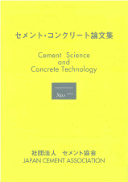Volume 65, Issue 1
Displaying 51-78 of 78 articles from this issue
Durability
-
2011 Volume 65 Issue 1 Pages 354-359
Published: February 25, 2012
Released on J-STAGE: March 29, 2013
Download PDF (1627K) -
2011 Volume 65 Issue 1 Pages 360-367
Published: February 25, 2012
Released on J-STAGE: March 29, 2013
Download PDF (1727K) -
2011 Volume 65 Issue 1 Pages 368-375
Published: February 25, 2012
Released on J-STAGE: March 29, 2013
Download PDF (1908K) -
2011 Volume 65 Issue 1 Pages 376-383
Published: February 25, 2012
Released on J-STAGE: March 29, 2013
Download PDF (2646K) -
2011 Volume 65 Issue 1 Pages 384-391
Published: February 25, 2012
Released on J-STAGE: March 29, 2013
Download PDF (1568K) -
2011 Volume 65 Issue 1 Pages 392-399
Published: February 25, 2012
Released on J-STAGE: March 29, 2013
Download PDF (2215K) -
2011 Volume 65 Issue 1 Pages 400-405
Published: February 25, 2012
Released on J-STAGE: March 29, 2013
Download PDF (1467K) -
2011 Volume 65 Issue 1 Pages 406-412
Published: February 25, 2012
Released on J-STAGE: March 29, 2013
Download PDF (2229K) -
2011 Volume 65 Issue 1 Pages 413-419
Published: February 25, 2012
Released on J-STAGE: March 29, 2013
Download PDF (1772K) -
2011 Volume 65 Issue 1 Pages 420-426
Published: February 25, 2012
Released on J-STAGE: March 29, 2013
Download PDF (1663K) -
2011 Volume 65 Issue 1 Pages 427-434
Published: February 25, 2012
Released on J-STAGE: March 29, 2013
Download PDF (1858K) -
2011 Volume 65 Issue 1 Pages 435-441
Published: February 25, 2012
Released on J-STAGE: March 29, 2013
Download PDF (1524K) -
2011 Volume 65 Issue 1 Pages 442-448
Published: February 25, 2012
Released on J-STAGE: March 29, 2013
Download PDF (2081K)
High-strength Concrete and High-Fluidity Concrete
-
2011 Volume 65 Issue 1 Pages 449-455
Published: February 25, 2012
Released on J-STAGE: March 29, 2013
Download PDF (1622K) -
2011 Volume 65 Issue 1 Pages 456-463
Published: February 25, 2012
Released on J-STAGE: March 29, 2013
Download PDF (1781K) -
2011 Volume 65 Issue 1 Pages 464-469
Published: February 25, 2012
Released on J-STAGE: March 29, 2013
Download PDF (1503K)
Fiber Reinforced Concrete
-
2011 Volume 65 Issue 1 Pages 470-476
Published: February 25, 2012
Released on J-STAGE: March 29, 2013
Download PDF (1957K)
Repair and Strengthening
-
2011 Volume 65 Issue 1 Pages 477-484
Published: February 25, 2012
Released on J-STAGE: March 29, 2013
Download PDF (4030K) -
2011 Volume 65 Issue 1 Pages 485-492
Published: February 25, 2012
Released on J-STAGE: March 29, 2013
Download PDF (1891K) -
2011 Volume 65 Issue 1 Pages 493-500
Published: February 25, 2012
Released on J-STAGE: March 29, 2013
Download PDF (1810K)
Recycling
-
2011 Volume 65 Issue 1 Pages 501-508
Published: February 25, 2012
Released on J-STAGE: March 29, 2013
Download PDF (2488K) -
2011 Volume 65 Issue 1 Pages 509-516
Published: February 25, 2012
Released on J-STAGE: March 29, 2013
Download PDF (1875K)
Other
-
2011 Volume 65 Issue 1 Pages 517-522
Published: February 25, 2012
Released on J-STAGE: March 29, 2013
Download PDF (1594K) -
2011 Volume 65 Issue 1 Pages 523-528
Published: February 25, 2012
Released on J-STAGE: March 29, 2013
Download PDF (2345K) -
2011 Volume 65 Issue 1 Pages 529-535
Published: February 25, 2012
Released on J-STAGE: March 29, 2013
Download PDF (3562K) -
2011 Volume 65 Issue 1 Pages 536-543
Published: February 25, 2012
Released on J-STAGE: March 29, 2013
Download PDF (1514K) -
2011 Volume 65 Issue 1 Pages 544-551
Published: February 25, 2012
Released on J-STAGE: March 29, 2013
Download PDF (1959K) -
2011 Volume 65 Issue 1 Pages 552-559
Published: February 25, 2012
Released on J-STAGE: March 29, 2013
Download PDF (1733K)
